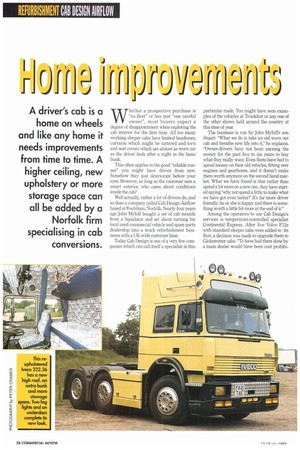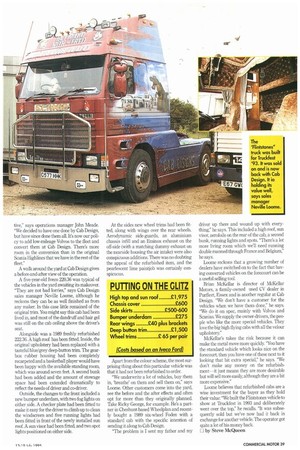A driver's cab is a home on wheels and like any home it needs improvements
Page 40

Page 41

If you've noticed an error in this article please click here to report it so we can fix it.
from time to time. A higher ceiling, new upholstery or more storage space can all be added by a Norfolk firm specialising in cab conversions.
hether a prospective purchase is "ex-fleet" or has just "one careful owner", most buyers expect a degree of disappointment when exploring the cab interior for the first time. All too many working sleeper cabs have limited headroom, curtains which might be tattered and torn and seat covers which are almost as worn out as the driver feels after a night in the basic bunk.
This often applies to the good "reliable runner" you might have driven from new. Somehow they just deteriorate before your eyes. However, as long as the customer sees a smart exterior, who cares about conditions inside the cab?
Well actually, rather a lot of drivers do, and so does a company called Cab Design Airflow based at Foulsham, Norfolk. Nearly four years ago John Myhill bought a set of cab moulds from a liquidator and set about turning his local used commercial vehicle and spare parts dealership into a truck refurbishment businesss with a UK-wide customer base.
Today Cab Design is one of a very few companies which can call itself a specialist in this particular trade. You might have seen examples of the vehicles at Truckfest or any one of the other shows held around the country at this time of year.
The business is run by John Myhill's son Stuart: "What we do is take an old worn out cab and breathe new life into it," he explains. "Owner-drivers have not been earning the money for the past five to six years to buy what they really want. Even fleets have had to spend money on their old vehicles, fitting new engines and gearboxes, and it doesn't make them worth anymore on the second hand market. What we have found is that rather than spend a lot more on a new one, they have started saying 'why not spend a little to make what we have got even better? It's far more driver friendly; he or she is happy and there is something worth a little bit more at the end of it."
Among the operators to use Cab Design's services is temperature-controlled specialist Continental Express. After five Volvo F12s with standard sleeper cabs were added to its fleet, a decision was made to upgrade them to Globetrotter cabs. "To have had them done by a main dealer would have been cost prohibi five," says operations manager John Meade. "We decided to have one done by Cab Design, but have since done them all. It's now our policy to add low-mileage Volvos to the fleet and convert them at Cab Design. There's more room in the conversion than in the original Scania Highlines that we have in the rest of the fleet."
A walk around the yard at Cab Design gives a before-and-after view of the operation.
A five-year-old Iveco 220.36 was typical of the vehicles in the yard awaiting its makeover. "They are not bad lorries," says Cab Design sales manager Neville Loome, although he reckons they can be as well finished as from any maker. In this case little remained of the original trim. You might say this cab had been lived in, and most of the dandruff and hair gel was still on the cab ceiling above the driver's seat.
Alongside was a 1989 freshly refurbished 222.36. A high roof has been fitted. Inside, the original upholstery had been replaced with a tasteful blue/grey deep-button trim. The gearbox rubber housing had been completely recarpeted and a basketball player would have been happy with the available standing room, which was around seven feet A second bunk had been added and the amount of stowage space had been extended dramatically to reflect the needs of driver and co-driver.
Outside, the changes to the front included a new bumper underdam, with two fog lights on either side. A checker plate had been fitted to make it easy for the driver to climb up to clean the windscreen and five running lights had been fitted in front of the newly installed sun roof. A sun visor had been fitted, and two spot lights positioned on either side. At the sides new wheel trims had been fitted, along with wings over the rear wheels. Aerodynamic side-guards, an aluminium chassis infill and an Eminox exhaust on the off-side (with a matching dummy exhaust on the nearside housing the air intake) were also conspicuous additions. There was no doubting the appeal of the refurbished item, and the pearlescent lime paintjob was certainly conspicuous.
Apart from the colour scheme, the most surprising thing about this particular vehicle was that it had not been refurbished to order.
"We underwrite a lot of vehicles, buy them in, 'breathe' on them and sell them on," says Loome. Other customers come into the yard, see the before and the after effects and often opt for more than they originally planned. Take Ricky George, for example. He's a partner in Cheshunt-based Wheelplan and recently bought a 1989 six-wheel Foden with a standard cab with the specific intention of sending it along to Cab Design.
The problem is I sent my father and my driver up there and wound up with everything,' he says. This included a high roof, sun visor, aerofoils on the rear of the cab, a second bunk, running lights and spots. "There's a lot more living room which we'll need running double manned through France and Belgium," he says.
Loome reckons that a growing number of dealers have switched on to the fact that having converted vehicles on the forecourt can be a useful selling tool.
Brian McKellar is director of McKellar Motors, a family-owned used CV dealer in Purfleet, Essex and is another regular at Cab Design. "We don't have a customer for the vehicles when we have them done," he says. "We do it on spec, mainly with Volvos and Scanias. We supply the owner-drivers, the people who like the more special vehicles. They love the big high flying cabs with all the velour upholstery."
McKellar's takes the risk because it can make the metal move more quickly. "You have the standard vehicle which looks nice on the forecourt, then you have one of these next to it looking that bit extra special," he says. "We don't make any money on the refurbishment—it just means they are more desirable but will sell more easily, although they are a bit more expensive."
Loome believes that refurbished cabs are a wise investment for the buyer as they hold their value: "We built the Flintstones vehicle to show at Truckfest in 1993 and deliberately went over the top," he recalls. "It was subsequently sold but we've now had it back in exchange for another vehicle. The operator got quite a lot of his money hack.
LI by Steve McQueen




























































































